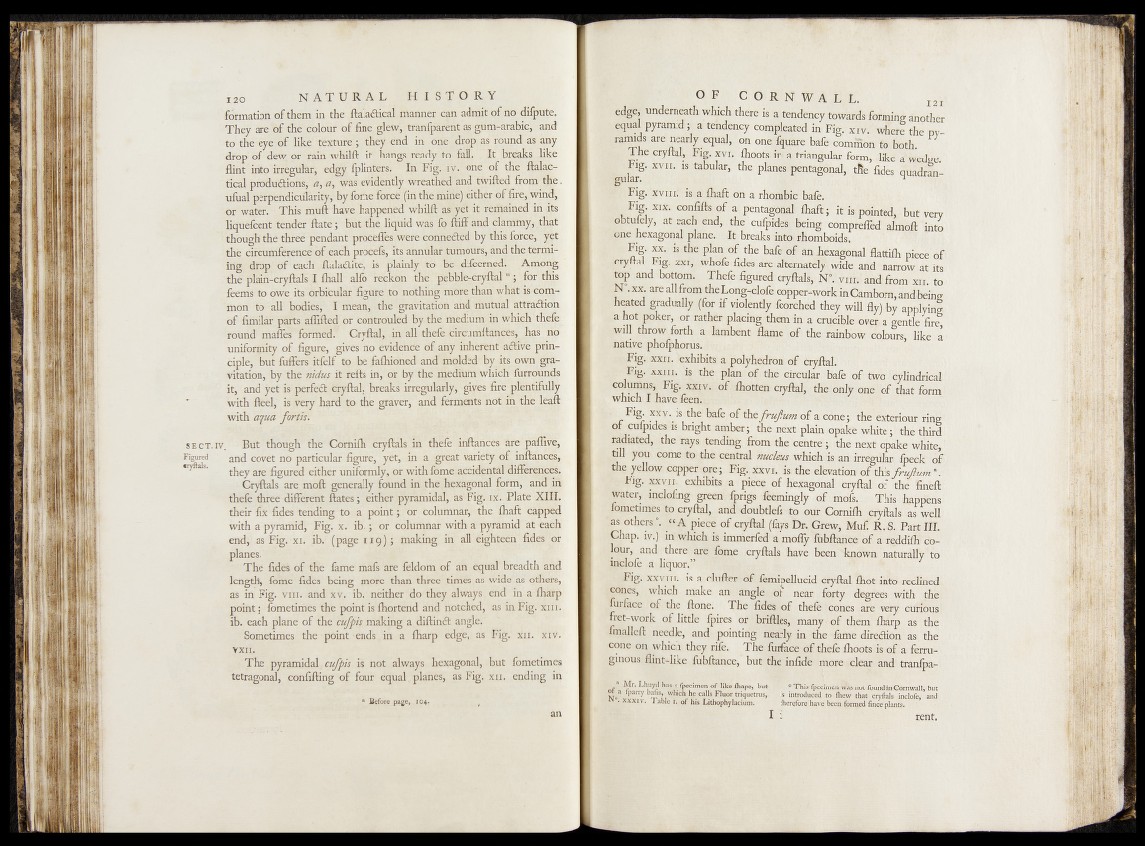
I20 : n a t u r a l n i s T o r y
formation of them in the ftäla&ical manner can admit of no difpute.
They are of thé colour of fine glew, tranfparent a|j^m-arabic, and
to théJ eye o f like'texture'; they énd in óne^drop as round-a's any
drop of dew or rain whilft it hangs ready to ‘fall. , It breaks like
flint into irregulär, edgy, fpliiiters. In Fig. iv. one of the ftalac-
tical productions, ä, ay was evidently wreathed and twilled from the.
ufual perpendicularity, by fome force'(in the mine) èithefèf fire, wind,
or water. T his muft have happened whilft as^yet it regained in ^s
liquefcent tender ftate'; but'the. liquid was fq ftiff and* clamUty#t that
though thé thrëe pendant procéffès were connected by this force, j^t
the circumference of each proqefs, Its’ännular tumoiirs, and the termi-
irig drop of each ftalaCtité, is plainly to be difeerned. Among
, the pläiri-cryftais I fhall alio reckon the pebble7cryftal ■ ; / for this
' fppmstn owe its orbicular figure to'nothing more than what is common
to all bodies, I mean, the gravitation and-mutual attraction
óf finrnlär parts affifted or cóntrouled by the medium in which thefe
round öafifö "fbrfeïèB? Cryftal, .in all tiplefe .circumftances; has no
uniformity of figure, gives flo evidence of any ‘"inherfenf -active pfin-
'• cipleybut fiiftersdtfelf to be falhioned ancPmoHed fiy ^s own gravitation,
by the nidus it refts in, or by the medium which furrounds
it, and yet is perfect cryftal, breaks irregularly, gives fire plentifully
with ftèèl, is very hard to the graver, and ferments not fe^the leaft
with aqua forttsr.
sect.rv. But though the Corhifh cryftals in thefe \inftances are paflive,
Figured covet no particular figure, yet, in a; .-great variety o f ipftahces,
they are figured either uniformly, or .with fome-accidental differences.
Cryftals are moft generally found in the, hexagonal form, and in
thefe three different ftates; either pyramidal, hsVFig. ix. Plate XIII.
their fix fides tending to a point; 'dr 'columnar, the fhaft capped
with a pyramid, Fig. x. it»..; or columnar with a pyramid at each
end, as Fig. xi. ib.* (page n g ) ; making in a lf eighteen fides or
planes.
The fides of the fame mafs are feldom of an equal breadth and
length, fome fides being more than three times as wide, as others,
as in Fig. vm. and xv. ib. neither do they always end in a fharp
point; fbmetimes the point is {hortend and notched, as in Fig. xm.
ib. each plane of the cufpis making a diftinCt angle.
Sometimes the point ends in a fharp edge, as Fig. xn. xiv.
Yxii.
The pyramidal. cufpis is not always hexagonal, but fometimea
tetragonal, confifting of four equal, planes, as Fig. xu. ending in
Before page, 104,
an
OF- d o R Kf WALL. I2I
edgepnderrieath which,there is^ te n d e n c y iu k ls forming another
D R pyramid'^; at tendency q H H 1 the
ramids are nearly equal,fou ontrfquare bafe common fo both.
|^The cr yf tal , , -Xvr . .fhoots » t r ia n g u la r W tlifed^ u ied g e .
* | i g ; xvir. ^tabular, .foe plan^fpentagonal, tile fides quadran-
Pl^ig- xviii? iss^ftiaft hn a rhomib bale, '
Fig. x i* confifts.of a pentagblh'lhaftf’it is pointed,- but very'
obtufely, at each end, the eulfpidef |eidg compreffed alnioft ‘into
k‘one hexagonal- plane. I | breaks.*into ||iomboids.
H E | g 1Sctjhe P)an the bafe of an hexagonal M B B W B B
cryftal Fig*, xxi, whoTe fides.dre-alternately, wide and'- narrow .at its
top and bottom^ THe(e.figured*cryftals, ^ i i f e ’ a h d f^ xH ^ to »
H 'XX; are a11 copper-work inCambok, stadbdag
heated gradually (for if violently,fcorched they will flk'byapplyiril
a hot poker, or rather placing them in a crucible oven a gentle” fire ~
H S throw forth, a lambent flame o f the rainbow flo u t s ,-dike a*
native pholphorus. &
% Fig . x x i i . exhibits a- polyhedron- of cryftal.
Pig- x x i i i . is the plan of the circular bale o f two cylindrical
columns#. Fig xxiv. of ■ fhotten cryftal, the only o n eM that form
Which I nave feen.:..
m Xf V‘. 1S, ^ ° f ti&frujiuniof a cone; the extetiour ring'
° a S ? ldeS fe Wght ambcrf the nCXt plain opkke white'; the third
radiated, the rays teridmg from the centre ;. the next opake white,'
y l l you come to the central nucleus which is ah. irregiilac fpeck 'ofo
Jhe yellow copper-ure; Fig..xxvi. is the elbvation'ofthis ftuftum
§ # § • jW r t t exhibits a piece of hexagonal cryftal of the lineft’
water, inclofing green fprigs feemingly ofsmdfs. This W e n s
lometimes to cryftal, and doubtlefs to our Cornifh ciyftals as well’
|P ' others.;'. “ A piece of cryftal (fays Dr. Grew, Muf R, S. Part III.
Chap, iv.) in which is immerfed a m o^ fobftance of a reddifh dbanc^
t^lere are fome cryftals have been known' naturally * to'
'J^flole a.-liiqnot.” *?,_■#, ' 41» 1
i- >Fig. xxviii. is a cluftervof femipellucid cryftal foot ir/tb reclined,
cones, which make an- angle of near forty degrees with the,*
furface of the ftone, The fides of thefe‘ cones arb vety ctiifbu's!
fret-work of little fpires or briftles, many - of them' fharp as‘ the
fmalleft needle, and pointing nearly in the fame direction as the
cone on which they rife. The furface of thefe fhoots.ia.of 'a ferruginous
flint-like fubftance, but'the infidfe more . clear and tranfpa-
M *' a fpedmen of like lhape, but' ).“ ,*>This fpfedmen,|§£ not'fouriiiniG&Jttwall, but
S .V f f W SJKrSBSSffih?SSgiFl«C(rtriquetrus, is introduced to.fhevy that crvftaisr htfoSej and
XXXIV- I .able i, of his Lithophylacium. therefore have been', formed finm? plant».
I i rent.